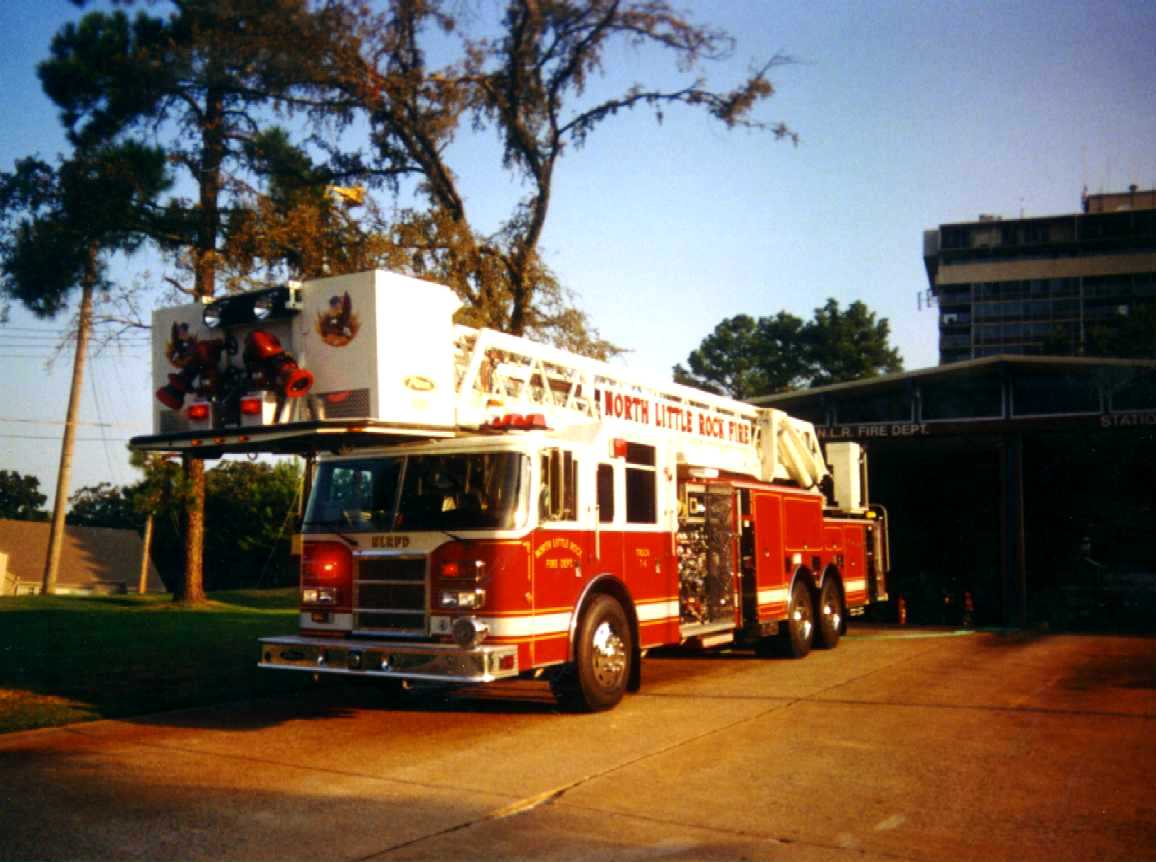| Apparatus Housed in NLRFD Station Number Seven |
| ENGINE 7 |
1995 E-ONE
CUSTOM |
1 Captain;
1 Lieutenant and
1-2 Fire Fighters
|
Delivered new in 2/ 95; 1250 GPM Pump; 500 Gallon Tank; High Compartments on both sides; Booster Line on top; Side Mount Pump Panel. Deck Gun. Carries defilibrator. |
TRUCK
7A |
2002 Pierce Dash 100' Elevating Platform / Quint |
1 Captain;
1 Lieutenant
and up to 1
Fire Fighter. |
100' Elevating Platform, full compliment of ground ladders, 2000 GPM Pump; 1000 Feet of 5 1/2 inch hose; booster tank; carries all forcible entry equipment, including power saws, etc. Carries Defilibrator on board. 300 Gallon Booster Tank. |
Truck 7A, a 2002 Pierce Quint and Engine 7, a 1995 E-One 1250 GPM Pumper are in front of Station 7 in the photo above. The pumper, delivered in February, 1995 is a "twin" of Engine 6. Station 7 opened in 1961. It was literally in the "middle of the woods." Only one side of Mc Cain Blvd. extended as far as Station 7. Everything else was woods east of the station.
Today NLR Fire Station #7 has an incredible amount of property to protect. Station 7 protects the Lakewood House, one of the tallest structures in the city, along with NLR High School East Campus, Lakewood Middle School, Lakewood and Crestwood Elementary Schools, Lakewood Village, Mc Cain Mall, The Other Center (which are three extremely large shopping areas) as well as Home Depot, the New Baptist Health Center -North Little Rock and many other businesses and homes of all descriptions. Station 7's District has a huge monetary value with all of the large shopping centers and malls.
Truck 7A protects the citizens of NLR north of I-30. It runs on all structure fire north of I-40, plus it also runs to the far west
(Engine 4's district).

Above: Truck 7A as it backs into the Station for the FIRST TIME on the new 100' Platform on August 19th. Note that the flashing red lights are still on. Truck 7A had to wait for the traffic signal in front of the Station 7 to change back to green, since Engine was just leaving on a rescue run. (See account at right.) There were about seven cars in front of 7A as it waited to pull into Station 7's driveway.
|
 Above: Engine 7 on its '95 E-One on August 19, 2003 -- When this photo was made, Engine 7 was leaving quarters on a rescue assignment. Truck 7A, on its brand new Pierce Platform, southbound on Mc Cain, was waiting for Engine 7 to get in the street (going on the run). Northbound on Mc Cain was a MEMS Ambulance, which was going to the same call that Engine 7 was. As soon as Engine 7 left the station and traffic was moving again , Truck 7A backed into Station 7 for the first time on the 2002 Pierce Platform (left). Above: Engine 7 on its '95 E-One on August 19, 2003 -- When this photo was made, Engine 7 was leaving quarters on a rescue assignment. Truck 7A, on its brand new Pierce Platform, southbound on Mc Cain, was waiting for Engine 7 to get in the street (going on the run). Northbound on Mc Cain was a MEMS Ambulance, which was going to the same call that Engine 7 was. As soon as Engine 7 left the station and traffic was moving again , Truck 7A backed into Station 7 for the first time on the 2002 Pierce Platform (left).
|

The Pride of the NLRFD: A 2002 Pierce Aerial Platform. A 100' Aerial ladder with a platform makes this the
ultimate weapon in fighting fire and in rescues. A 2000 GPM Pump, along with 1000 feet of 5 1/2 inch hose
make for a 1-2 punch in fighting major fires. A 300 Gallon Booster Tank and smaller hose above the pump
panel enable this truck to respond on smaller fires, if the need arises. A full compliment of ground ladders
is also carried on this truck. This apparatus is fully Air-Conditioned. --- And a "Q-Tone" Siren!
|
Interesting Facts about Station 7 and Companies 7 and 7A: When Station 7 first opened, it was in the woods! Only one side of Mc Cain was paved - the side that connected with Station 7. There was not one structure within several blocks of Station 7
upon its Grand Opening! The 1961 International/Central that was Engine 7'S first pumper and its sister pumper at Station 8 were
the first two vehicles of the N.L.R.F.D. to have air brakes. When Engine 7 finally got an alarm, the air pressure was low on the
pumper, so the crew had to pump up the air pressure before the truck could leave the fire station. This, obviously, was not going
to work, since it took almost two minutes to pump up sufficient air pressure. An auxilliary air tank was installed in the cab on the
driver's side. If the air pressure was low, a lever connecting to a value on the tank was worked by the driver, and there was instant
air pressure in the system, so the pumper ould go on a run immediately!
Back to the NLRFD Unofficial Home page
|